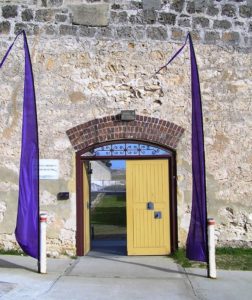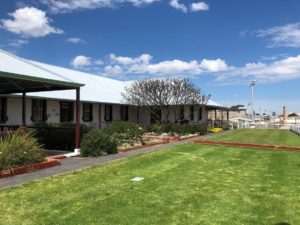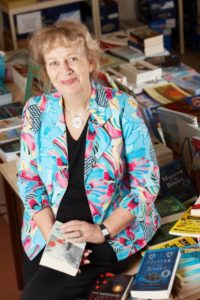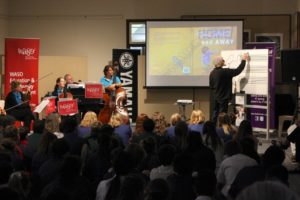| The Literature Centre, Fremantle, Australia
Olivia Mair |
Download PDF |
The Literature Centre, Fremantle, Australia
Figure 1: The entrance to The Literature Centre, Fremantle, Australia
You enter The Literature Centre via a cheerful yellow gate set in a six-metre high limestone wall. If it were not for the door and the signage, there would be little in the immense and austere wall to hint at the intimate and illuminating spaces that lie within its confines. Built with convict labour in the nineteenth century, the wall forms a perimeter around what was once one of Australia’s most notorious maximum-security prisons, Fremantle Prison. It towers over the Western Australian port city. These days the watch towers atop the wall are empty, but from the outside, the place still speaks of confinement and severity.
Figure 2: The Literature Centre is located in the former hospital of Fremantle Prison
Since the prison was decommissioned in 1991, its 20 buildings have been occupied by cultural, tourism and community organisations, and in 2010 the building gained UNESCO World Heritage listing in acknowledgement of its cultural significance as a [end of page 1] convict site. The Literature Centre is housed in what was the prison hospital, its wards now dedicated to nurturing Australian literature for children and young adults and celebrating books, writing and illustrations. It is a house-like structure with wide verandas and gardens, set apart from the rather grim-looking cells over the other side of the courtyard.At the time of my visit in August 2018, The Literature Centre had two significant exhibitions of artwork by Freya Blackwood for The Feather, written by Margaret Wild, and by Shaun Tan for his latest book, Cicada. The Feather, whose images are characterised by a chiaroscuro effect with shadowy backgrounds and grey tones lit up by an otherworldly glow, is about hope and redemption in a dystopian world. This exhibition led viewers through all the original artwork. The very intriguing Shaun Tan exhibition included the original artwork for the book, as well as a video recording of Tan talking about the evolution of his ideas, photos of him at work, sketches and a 3D cicada model he had made. All of this pointed to the complexity of picturebook making and the many modes and media that combine to make meaning. It struck me that the themes of both books seemed particularly apposite in a cultural and educational centre located in a former prison. Cicada, which [end of page 2] focuses on oppression, conformity and ultimately transformation, ends with an unforgettable image of flight and transcendence.
The intellectual and manual processes underpinning the making of a picturebook is one of The Literature Centre’s reasons for being. ‘I wanted to show children the whole process of creating a book, from the very beginning of an idea scrawled on the back of a grotty envelope all the way through to the completed book’, the centre’s director Lesley Reece said in a recent interview (cited in Wales, 2018, p. 90). Reece founded the centre 25 years ago and it reaches 35,000 children and young adults annually through a variety of programmes. It has a regular cycle of exhibitions, workshops and school outreach events and each year it hosts a national conference on Australian children’s and young adult fiction. Throughout the year there is a young writers’ programme that enables aspiring writers to attend sessions with well-known Australian young adult authors. Reece also works with a team of educators to hold author and illustrator, poetry and picturebook sessions both at the centre and schools. The programme extends to Western Australia’s remote regional areas.
Figure 3: Lesley Reece founder and director of The Literature Centre [end of page 3]
Educating the public about children’s and young adult literature, nurturing and promoting authors and illustrators and supporting educators in using literature are Reece’s passions. Her first career was as a teacher in Queensland, at the other side of the country. In the 1970s she taught in Australia’s aid programme for several years, updating key educators from developing countries on both their English language and teaching methodology. She has had a longstanding passion for children’s literature and began working on the promotion of children’s literature while living in Ireland with her family. There, the absence of support for local literature led her to establish the Irish Children’s Book Trust. Reece’s work in raising the profile of Irish children’s literature was recognized by then president of the Republic of Ireland, Mary Robinson, who launched her book, Irish Guide to Children’s Books. Decade 1980-1990, edited with Gabriel Rosenstock. On her return to Australia Reece established The Literature Centre with the aim of showcasing Australian children’s literature and the craft of writing and illustrating. There is no other centre like it in Australia.
The Literature Centre is not just about picturebooks, of course, although they are a major focus. One of the things Reece most wanted to highlight at the centre, was the way the picturebook emerges from an interweaving of different materials, modes and skills whose meanings are also shaped by the cognitive processes and perspectives of readers. Shaun Tan wrote about this synergy in an essay for Lingua Franca (2010): ‘When working I often like to think of words and images as opposite points on a battery, creating a potential voltage through a ‘gap’ between telling and showing. It requires the reader’s imagination to complete the circuit, their thoughts and feelings being the current that fills the silent space, without prescription’.
Now, through a series of workshops entitled ‘The Sounds of Picturebooks’, The Literature Centre is exploring another dimension of picturebooks, the acoustic mode. The acoustic nature of picturebooks and their potential use for raising phonological awareness and enhancing active listening skills in language and literacy education has long been recognised (Fleta, 2017). The Literature Centre is drawing on these rich pedagogical possibilities and adding music for a series of workshops with author, illustrator and composer Matt Ottley. During the workshops, Ottley brings his multimodal ensembles to life with the help of the West Australian Symphony Orchestra. [end of page 4]
Figure 4: Matt Ottley demonstrates music composition and illustration in ‘The Sounds of Picturebooks’ workshop
The centre has been responsible for launching some of Australia’s best-loved authors and illustrators, many of whom have gone on to achieve international status. Isobelle Carmody says no place has quite had the same impact on her as The Literature Centre: ‘I have stayed at many writers’ centres in the world, always striving for the unnameable something that will enliven me. It is not that one wishes to be in a place so that one can be inspired to write stories about them, but that the place should offer something that brings the creative spark flaming to life’ (author statements, The Literature Centre). And Shaun Tan credits the centre with having served as a springboard for a successful career: ‘It was an indispensable port-of-call during my early years as a freelance illustrator,’ he said. ‘I’m very lucky that I happen to have been born in the same city’ (author statements, The Literature Centre).
The Literature Centre
Corner Knutsford St and Hampton Rd,
Fremantle, Western Australia
www.thelitcentre.org.au
All photos supplied by The Literature Centre. [end of page 5]
Bibliography
Blackwood, F. and Wild, M. (2018). The Feather. Melbourne and London: Hardie Grant Egmont.
Tan, S. (2018), Cicada. Melbourne: Hachette
References
Fleta, T. The Sounds of Picturebooks for English Language Learning. Children’s Literature in English Language Education Journal, 5 (1), 21-43.
Fremantle Prison History. Retrieved from: http://fremantleprison.com.au/history-heritage/history/a-brief-history/
Reece, L. & Rosenstock, G. (1990). Irish Guide to Children’s Books. Decade 1980-1990. Dublin Irish Children’s Book Foundation.
Tan, S., (2010), Words and Pictures: An Intimate Distance, Lingua Franca, Radio National ABC, 1-7. Retrieved from http://www.shauntan.net/images/essayLinguaFranca.pdf
Wales, L. (2018 October 13), Inspiring Words. The Post, 89-90. Retrieved from https://postnewspapers.com.au/wp-content/uploads/13102018.pdf
Olivia Mair (PhD) is an adjunct lecturer at Università Cattolica in Milan. Her research interests include early years second language (L2) education, children’s literature in L2 education and Content and Language Integrated Learning (CLIL). She co-edited English for Young Learners from Pre-school to Lower Secondary: a CLIL Teacher Training Project in Italian Schools (2018). [end of page 6]





